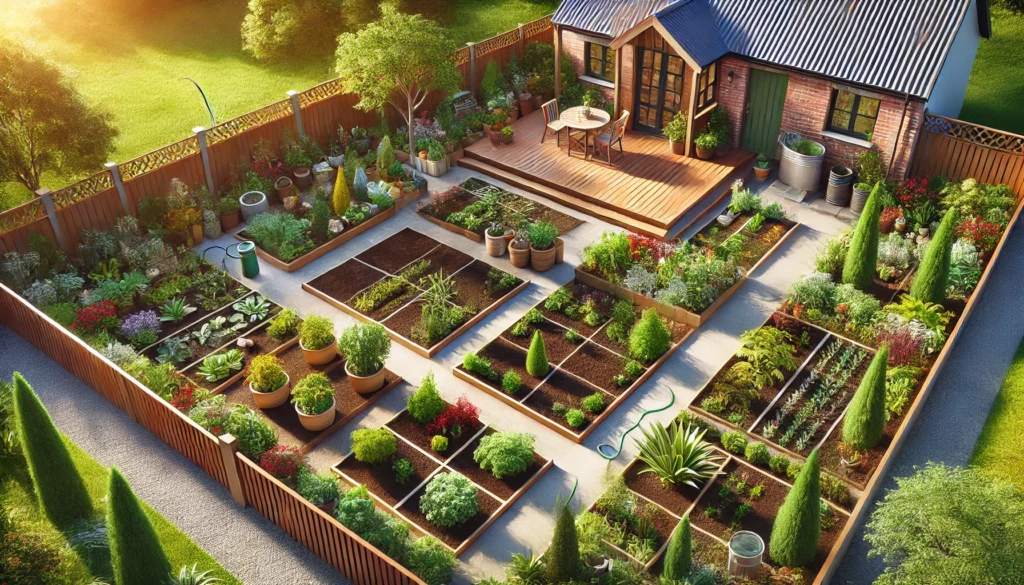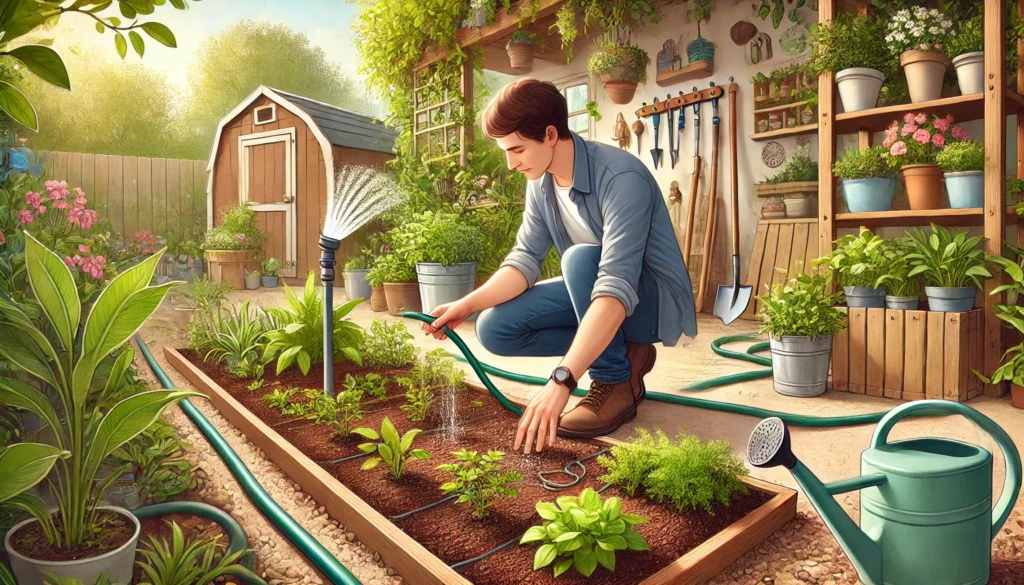How to Plan a Garden: Expert Layout and Planting Advice
Planning your garden is a crucial first step towards creating a thriving, productive, and beautiful outdoor space. Proper planning ensures you make the most of your available space, select the right plants, and create a layout that suits your needs and preferences. According to garden research, 77% of American households participate in some form of gardening activity, highlighting the popularity and importance of this hobby.
This guide will take you through the essential aspects of garden planning, covering everything from site selection and garden design to plant selection and seasonal planning. Whether you’re a novice or an experienced gardener, this guide will provide you with the tools and knowledge you need to succeed.
Importance of Garden Planning
Garden planning is essential for several reasons:
- Maximizes Space Utilization: Proper planning helps you make the most of your available space, ensuring every inch is used effectively.
- Ensures Optimal Growing Conditions: By considering factors such as sunlight, soil type, and water availability, you can create a favorable environment for your plants.
- Increases Productivity: A well-planned garden can yield more produce and reduce the likelihood of plant diseases and pest infestations.
- Reduces Maintenance: Thoughtful planning can minimize the effort required to maintain your garden throughout the growing season.
1. Site Selection
Choosing the best location for your garden is critical as it determines the amount of sunlight, soil quality, water access, and air circulation your plants will receive.

Choosing the Right Location
Selecting the right location for your garden is critical. Here are the key factors to consider:
- Sunlight: Most vegetables and flowers require at least 6-8 hours of direct sunlight daily. Observe your yard to identify areas that receive ample sunlight.
- Soil Quality: Test your soil to determine its pH and nutrient content. Amend the soil with compost or other organic matter to improve its fertility and structure.
- Water Access: Ensure your garden is located near a water source for easy irrigation. Avoid low-lying areas where water might pool and cause root rot.
- Air Circulation: Good airflow helps prevent fungal diseases and promotes healthy plant growth. Avoid planting too close to buildings or solid fences that can block wind.
2. Garden Design
Organizing your garden layout to maximize growth and accessibility is essential. It includes deciding between in-ground beds, raised beds, or container gardening, and planning pathways for easy access.

Layout Planning
Designing the layout of your garden involves organizing plants to maximize growth and accessibility. Here are some key considerations:
- Garden Beds: Decide between traditional in-ground beds, raised beds, or container gardening based on your space and preferences. Raised beds offer better drainage and soil control, while containers are great for limited spaces.
- Raised Beds: Elevated garden beds provide excellent drainage, prevent soil compaction, and can be filled with high-quality soil. They are ideal for small spaces and urban gardens.
- Containers: Perfect for patios, balconies, or small yards. Containers allow you to control soil quality and move plants as needed to capture optimal sunlight.
- Plant Arrangement: Group plants with similar sunlight, water, and soil needs. Use companion planting techniques to enhance growth and deter pests.
- Examples: Plant basil next to tomatoes to improve growth and flavor. Place marigolds around the garden to deter nematodes and other pests.
- Pathways: Include pathways in your design to allow easy access for planting, watering, and harvesting. This also helps prevent soil compaction.
Tip: Use materials like gravel, mulch, or stepping stones to create durable and attractive paths.
Planning Tools
Utilize garden planning software to visualize your garden layout and optimize plant placement. Tools like the Almanac Garden Planner can help you calculate planting dates and space requirements.
How Planning Helps Utilize Every Inch of Available Space
- Vertical gardening techniques such as trellises, hanging planters, and stacked pots can maximize growing areas.
- Square foot gardening, where each square foot of garden space is planned for a specific plant, helps in making optimal use of space.
Examples of Efficient Garden Layouts
- Raised bed gardens with companion planting.
- Container gardens on patios and balconies.
3. Selecting Plants
Selecting plants involves choosing the right crops for your garden based on climate compatibility, seasonal growth patterns, and personal preferences. This step ensures that you grow plants that will thrive in your specific conditions and meet your culinary or decorative needs.

Choosing Suitable Plants
When selecting plants for your garden, consider the following:
- Climate Compatibility: Choose plants that thrive in your climate zone. Check the USDA Plant Hardiness Zone Map to determine your zone and select appropriate plants.
- Seasonal Plants: Plan for a mix of cool-season and warm-season crops to ensure continuous harvest throughout the year.
- Personal Preferences: Grow plants that you enjoy eating or using. This ensures that your garden is both productive and enjoyable.
Companion Planting
Companion planting involves placing certain plants together to benefit each other:
- Pest Control: Some plants repel pests or attract beneficial insects. For example, planting marigolds can deter aphids.
- Improved Growth: Certain plant combinations can enhance growth. For instance, planting beans near corn provides nitrogen to the soil, benefiting the corn.
4. Soil Preparation
Soil preparation is the process of enhancing soil quality to provide a fertile growing environment. This involves testing soil, adding organic matter, and ensuring proper drainage. Healthy soil is essential for robust plant growth and high yields.

Building Healthy Soil
Good soil is the foundation of a successful garden. Here’s how to prepare your soil:
- Soil Testing: Test your soil to determine its pH and nutrient levels. Amend as necessary based on the results.
- Organic Matter: Incorporate compost, leaf mold, or well-aged manure to improve soil structure and fertility. These materials increase the soil’s ability to retain moisture and nutrients.
- Drainage: Ensure proper drainage by avoiding compacted soil. Raised beds can help improve drainage in areas with heavy clay soil.
5. Water Management
Water management focuses on efficient irrigation practices to ensure plants receive adequate moisture without wastage. This includes setting a watering schedule, using drip irrigation, and applying mulch to retain soil moisture. Proper water management promotes healthy plant growth and conserves resources.

Efficient Irrigation
Proper watering is essential for healthy plant growth. Here are some tips for efficient irrigation:
- Watering Schedule: Water deeply and less frequently to encourage deep root growth. Morning is the best time to water to minimize evaporation.
- Drip Irrigation: Use drip irrigation or soaker hoses to deliver water directly to the plant roots, reducing water waste and preventing fungal diseases.
- Mulching: Apply mulch around plants to retain soil moisture, suppress weeds, and regulate soil temperature.
6. Preventing Overcrowding
Preventing overcrowding is crucial for ensuring healthy plant growth and reducing pest issues.
Consequences of Overcrowding
- Poor Growth: Plants compete for nutrients, light, and water, leading to stunted growth.
- Increased Pests: Overcrowded plants are more susceptible to pests and diseases due to poor air circulation and stress.
Tips for Maintaining Proper Spacing as Plants Grow
- Thinning: Regularly thin seedlings to ensure adequate space for growth.
- Staggered Planting: Plant in intervals to avoid all plants maturing at the same time.
- Using Supports: Use trellises and cages to support plants and keep them spaced appropriately.
7. Seasonal Planning
Seasonal planning involves organizing your gardening activities to take advantage of different growing seasons. This includes succession planting, crop rotation, and using cover crops to maintain soil health year-round. Effective seasonal planning ensures continuous harvests and sustainable garden productivity.

Year-Round Gardening
Plan your garden to provide harvests throughout the year:
- Succession Planting: Plant crops in succession to ensure continuous harvests. For example, after harvesting early lettuce, plant beans in the same space.
- Crop Rotation: Rotate crops each year to prevent soil depletion and reduce the risk of pests and diseases.
- Cover Crops: Plant cover crops in the off-season to improve soil health and prevent erosion.
8. Sustainable Practices
Sustainable practices in gardening aim to minimize environmental impact and promote eco-friendly techniques. This includes composting, rainwater harvesting, and using native plants. Adopting sustainable practices helps create a self-sustaining garden that benefits both the environment and the gardener.

Eco-Friendly Gardening
Incorporate sustainable practices to create an environmentally friendly garden:
- Composting: Compost kitchen scraps and garden waste to create nutrient-rich compost for your soil.
- Rainwater Harvesting: Collect rainwater to use for irrigation, reducing your dependence on municipal water.
- Native Plants: Use native plants that are adapted to your local climate and require less water and maintenance.
9. Budgeting and Resources
Budgeting and resources cover strategies to manage garden expenses effectively and make use of available resources. This includes DIY projects, seed saving, and leveraging community resources. Cost-effective gardening ensures you can maintain a productive garden without excessive spending.

Cost-Effective Gardening
Gardening doesn’t have to be expensive. Here are some tips to keep costs down:
- DIY Solutions: Build your own raised beds, compost bins, and trellises from reclaimed or inexpensive materials.
- Seed Saving: Save seeds from your plants to use next season, reducing the need to buy new seeds.
- Community Resources: Join a local gardening club or community garden to share resources, tools, and knowledge.
Additional Beginner-Friendly Tips
Starting Small
- Benefits of Starting with a Manageable Garden Size: Easier to maintain and less overwhelming for beginners.
- Tips for Expanding Your Garden Over Time: Gradually increase garden size as you gain experience and confidence.
Keeping a Garden Journal
- Importance of Tracking Your Gardening Activities: Helps monitor progress, identify issues, and learn from experiences.
- What to Include in Your Garden Journal: Planting dates, growth progress, weather conditions, pest problems, and solutions.
Patience and Experimentation
- Understanding That Gardening Involves Learning and Experimenting: Be prepared for trial and error; not every plant will thrive.
- Encouragement to Try New Plants and Techniques: Experiment with different plants, gardening methods, and layouts to find what works best for you.
Conclusion
Planning your garden is a foundational step that sets the stage for a thriving garden. By carefully selecting the site, designing an efficient layout, and choosing suitable plants, you can create a garden that is both productive and easy to maintain. Remember to take the time to plan thoroughly, as this will save you time and effort in the long run.
Next Steps
In the next guide, we will delve into “Step 2: Preparing Your Soil”, where we will cover soil testing, amendments, and preparation techniques to ensure your garden soil is in top condition for planting.


